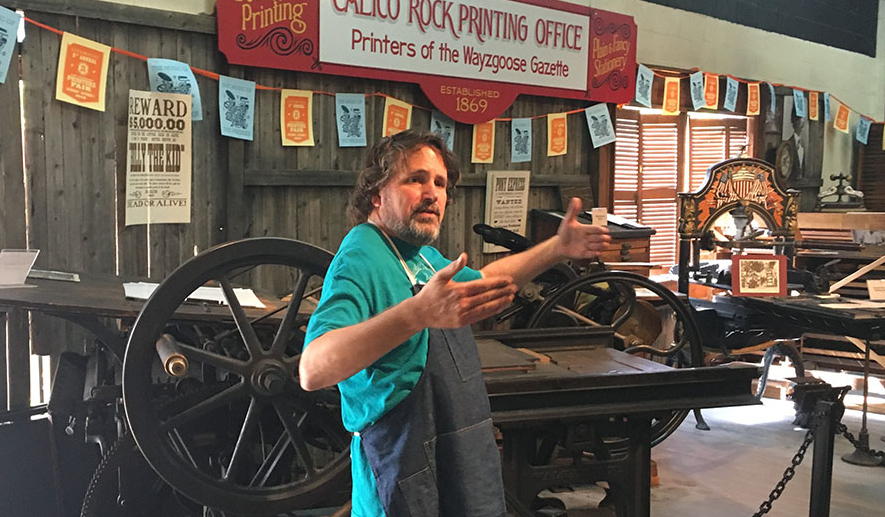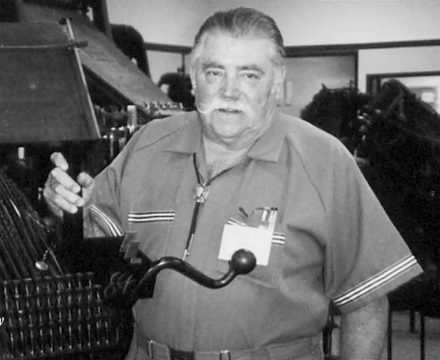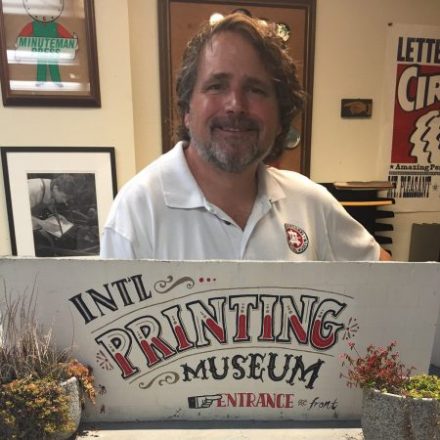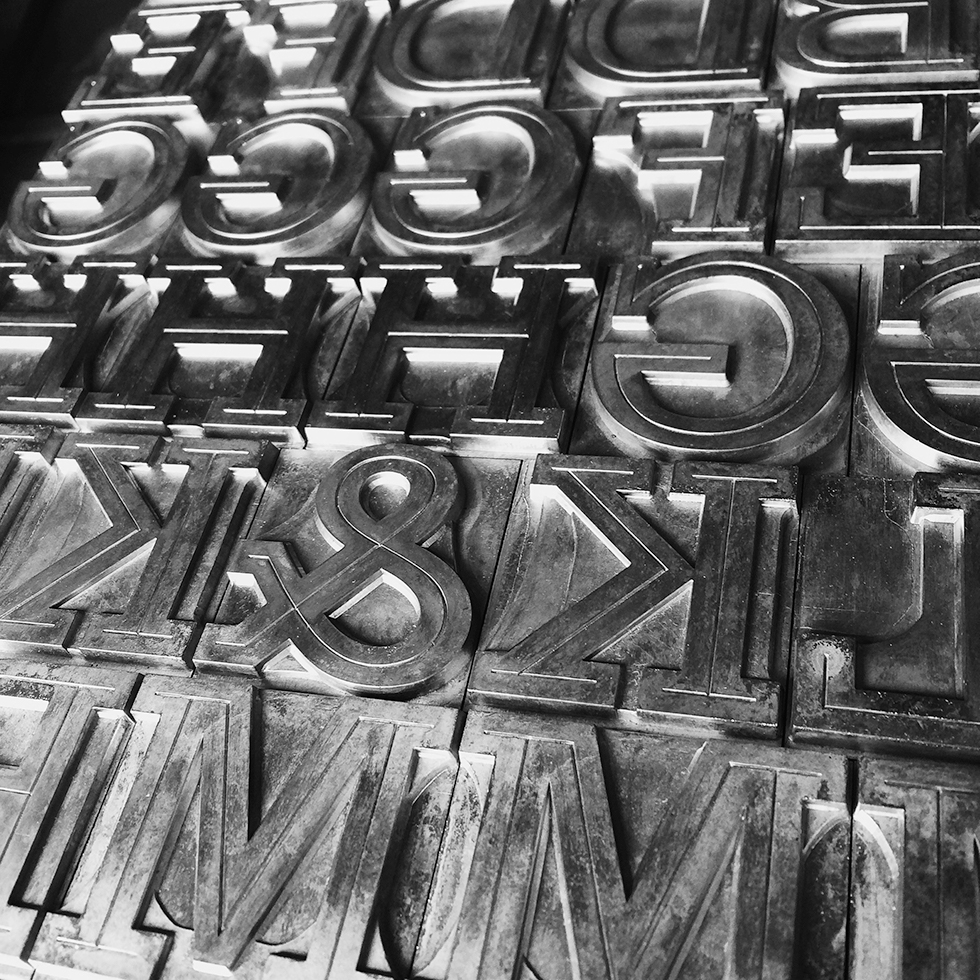
Mark Barbour is an influential figure in the letterpress world that has been crafting his legacy through his leadership and creativity for the past 30+ years at the International Printing Museum in Carson, California. Passing on the history and importance of printing to thousands of people each year through his role as the curator of the International Printing Musem, is only the beginning of Mark’s contribution to the letterpress world.
Growing up in the Bay Area, Mark found a love for letters in his middle school years through calligraphy. In 7th grade, he was introduced to the art form through a calligraphy class that he took two days a week at his catholic school. The next year, he began to do some free-lance lettering on the side. By his junior year of high school, he was teaching classes in calligraphy. But it wasn’t until his senior year that he discovered printing. Mark said, “When I discovered the shop course as a senior in high school, it just dawned on me that that was a logical connection to my love for letters.” His background in calligraphy and love for letters fed right into his love for printing.
After high school, Mark decided to go to college at California Polytechnic University to study Printing Management and Graphic Design. During his college years, he and a few other students helped run the printing museum at the university that was in the basement of a building on campus. This experience was his first taste of running a museum. Little did he know that this would be the start of his 30+ year career as a printing museum curator. He said, “while I was running that museum, there was no concept that this was a career. I was just doing it because I loved it and it was a hobby there at school, and I started printing books, giving tours, and it became just part of me and who I was.”

Source: https://www.printmuseum.org/collection/lindner-collection/
Along with the other students who helped run the museum, Mark got the opportunity to take a trip down to Los Angeles visit and get inspiration by Ernest (Ernie) A. Lindner’s massive letterpress collection and shop. Ernie’s shop was located in what was then the printing district of Los Angeles. Mark told me that, “In all the big cities, for the most part, the printers, like most trades, tended to be near each other. So, all the supply houses, the printers, the people who do typesetting, everything is nearby. And that is no longer the case pretty much anywhere.” Today, this area of Los Angeles is known as the fashion district. Ernie, equipped with big rosy red cheeks and a handlebar mustache, was a “colorful character” as described by Mark. Mark remembers being in awe of Ernie’s shop that first day and then later that afternoon going to the museum of science and industry where his collection was on display in the early 1980s. Mark described walking into the collection and seeing more presses then he could ever imagine growing in size from small little ones to massive presses. Mark described it as, “Everything you can imagine and your eyes just are like ‘wow’”. Mark said that after he got home and was reminiscing on the trip he remembers just not being able to fathom that there was a collection like Ernie’s that truly existed because of how extensive it was. He said, “That was the best I could dream of at that age.”
“He lives the story of life” – Mark Barbour on Ernie
One thing that really stuck with me after my interview with Mark was how he talked about Ernie. It was clear how inspired Mark had been by him. Mark told me stories of how before Ernie passed away, at the age of 72 he decided that he wanted to take a trip to the North Pole. So, he did. The following year, he decided that he wanted to go to the South Pole. So, he did. Mark said that he even has a picture of Ernie standing next to the marker that is in place at the South Pole. Mark described Ernie as someone who “lives the story of life”. To me, that is a pretty amazing thing to say about someone and how I think most of us hope to be remembered someday.

Source: https://fascinatingnouns.com/mark-barbour/
Once Mark got to his senior year at California Polytechnic University he began to think about his future and didn’t know exactly what that was going to hold for him. He thought about going on to graduate school and did some interviews there but nothing seemed to stick. Until his department head went to a black-tie event down in Los Angeles at what would become the International Printing Museum. Mark said that when he got back from his trip he called Mark into his office and said: “Mark, do I have the job for you”. After that, everything seemed to fall into place so following his graduation from Cal Poly, he said yes to the opportunity of a lifetime, moved down to Los Angeles and become one of the founders and curators of the International Printing Museum. 30 some years later Mark is still running the museum and has built something that will carry on the story of printing far beyond any of us. Mark described this experience of getting such an amazing opportunity fresh out of college as, “Everything I want to do in life. My hobbies, career goals, passions. Everything I want to do. It’s my first job out of college”.
Something that I found so inspiring about Mark and his story is how he has been able to live out his dream and make a career out of something he is so passionate about. I asked him how it has been getting to have a career that he is so passionate about, he said, “The nature of this process is that it wasn’t a goal. Like sitting down one day and thinking through what are my passions? How do I wrap my life around that? Or, make a career out of it? How do I pursue that? For me, it’s always just been passion about what I am doing and engaging in it with intensity and somehow it starts wrapping around your life.” He told me that others have given him the analogy that his career has been like a tight-fitting glove. He went on to explain this by saying, “You couldn’t have asked for a more perfect fit to wrap around my interests, my passions, my skill set, my direction.”
“For me, it’s always just been passion about what I am doing and engaging in it with intensity and somehow it starts wrapping around your life.”
– Mark Barbour
Mark started the museum along with two other men: Dave Jacobson and Ernie Lindner. Dave was the underwriter and Ernie provided his collection. But, Mark has done much more than simply be the founder or curator for the printing museum for the past 36 years. He has created an experience for everyone that gets to engage with him. Mark said that from the beginning his goal was always to “create a storytelling session for everybody who came into the museum.” He has turned the museum into an interactive experience where people of all ages can come and hear the stories behind the printing press, a place where people can engage in the art form, and a place where people can come to learn about one of the most important inventions of all time. Being an avid collector himself, Mark has been able to duplicate the already impressive collection that Ernie gave to the museum. Now, the museum has over 1,000 fonts of wood type, 5,000 to 8,000 fonts of metal type, casting machines, 50 different varieties of platen presses, and so much more.

Source: https://www.mercurynews.com/2014/07/02/charming-prints/
Being a storyteller himself. Mark understands the power of a good story and the effect that it can have on a person. He said, “for me, it’s a fantastic thrill to watch the lights turn on in someone’s head. When you see them really engage in the subject, I know for the most part that everyone who walks into the door really could care less about the printing museum. And I know that, so that’s my challenge.” Through the museum, Mark has created an outreach program called “History in Motion”. With this, he brings stories about the history of printing, literature, inventions, inventors, and much more to children all across the west coast. Each year he gets to share his knowledge with 20,000 – 25,000 school children. To date, he has been able to reach about 1 million kids with his stories about how printing has changed the course of civilizations and is a big reason as to why our lives look the way that they do today. Without Gutenberg inventing the printing press in the 15th century we wouldn’t have been able to spread knowledge and get the masses educated. We wouldn’t have been able to make the advancements in technology and ideology that came after. We wouldn’t be where we are today without printing. That is the impactful message that Mark shares with the visitors of the International Printing Museum.
Not only is Mark surrounded by the world of printing at the museum, but back at home, he has his own collection as well. He described printing as, “one of the great hobbies that exist out there, there is so much you can do with it.” Along with his presses, he has collections of wood type, metal type, and ornaments as well. Mark proclaimed “I’m a sucker for decorative and ornaments. I got too many that I don’t know what I have.” He told me that out of his own collection of presses, his favorite press is his Pearl from 1895. He loves how printing allows him to use so many different pieces that all have their own story of how they were used before and how they found their way into his shop and now he has the ability to use them to create something brand new. From having his own shop, to hobby printing on the side, to working at a printing museum and getting to pass along the history of printing to thousands of people each year, Mark has created a life where he gets to live out his passion for the world of printing each and every day.

Source: https://www.dailybreeze.com/2019/08/12/south-bay-history-carsons-international-printing-museum-takes-its-educational-mission-seriously/
One thing that Mark shared with me that I thought was so unique was that one of his goals is to be a “fork in the road” for people. The metaphor “fork in the road” can be described by some as a defining moment in life or history. Mark defines it as “something that happens in your life, an experience, a ‘wow” moment.” Mark says that his goal has always been to be a fork in people’s journeys. To tell a story that creates that ‘wow’ moment for people. To deliver an experience to people that they will always remember. To create a defining moment where the light bulb turns on in someone’s head and they see how powerful printing can be.
Speaking with Mark, anyone can see his passion for printing and all that it has brought into the world. He shared with me one of his favorite quotes from Charles Dickens that says, “Of all inventions, of all the discoveries in science or art, of all the great results in the wonderful progress of mechanical energy and skill, the printer is the only product of civilization necessary to the existence of free man.” Mark interprets what Dickens is saying here as, amidst everything that was going on when this quote was said in the 19th century with the industrial revolution and all of the new machines that were being created, Dickens acknowledged that printing was still the most important of them all. Without printing, knowledge would’ve never been able to spread to the masses. Without the spread of knowledge, who knows where we would be today. The fact of the matter is that you can trace all of the technological advances back to the invention of the printing press. Mark says, “It is everywhere, it is in the fabric of civilization.” Mark went on to talk about how Gutenberg was named “the man of the millennium” because without his invention of the printing press our lives would be very different from what they are today. The printing press was the start of it all. Even just in my one conversation with Mark, he shared so much knowledge with me about printing and really made me see just how important it is in all of our lives but most people don’t even realize it.
“How do I take something called a printing museum and make it permanent?”
– Mark Barbour
The thing that I was most curious about with Mark was the legacy that he wants to leave on the world. It is clear to me that he has impacted the lives of so many people who he has been able to pass on his knowledge to. I, as well as many others I’m sure, can see how Mark’s life has been so influential to so many children, to the printing world, and especially in all that he has been able to accomplish and create with the museum that can live on far past his lifetime. When I asked Mark about his legacy this is what he told me, “it’s not easy to get a printing museum to live and exist beyond your lifetime – that’s been my challenge. How do I take something called a printing museum and make it permanent? That’s where I’m at now, is trying to figure out before I’m done, is how to have a permanently established museum that maintains its flavor and its character of being a working and engaging collection that has all of these different audiences that come to the museum and do stuff from school kids, to college kids, to seniors, to tourists, to the general public, and the artists that are learning, and to make it permanent.”
